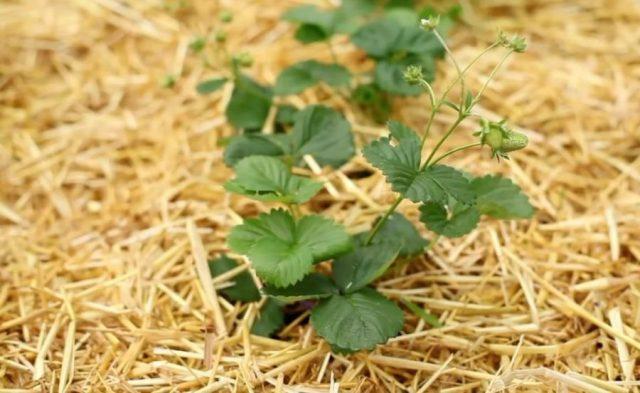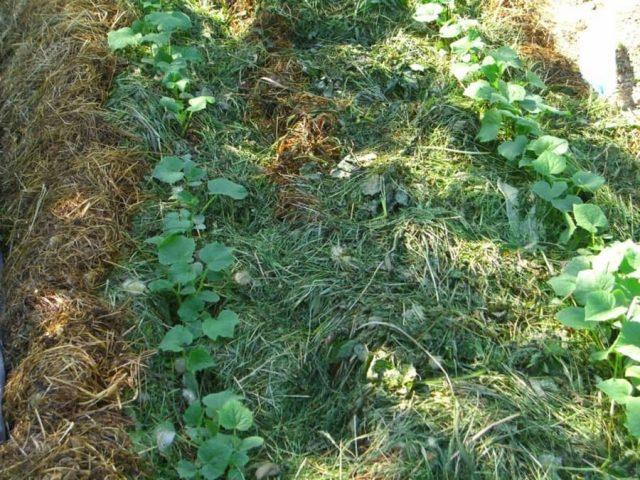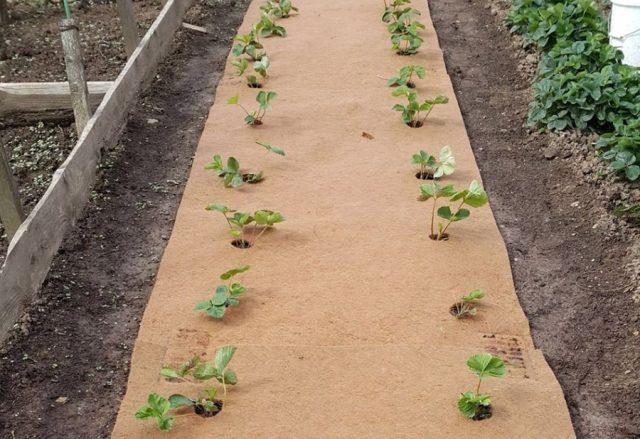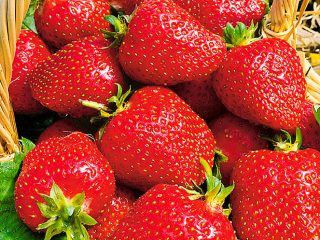Content
- 1 What is soil mulching for strawberries?
- 2 When to mulch strawberries
- 3 What is the best way to mulch strawberries?
- 3.1 Is it possible to mulch strawberries with pine needles?
- 3.2 How to mulch strawberries with straw
- 3.3 Is it possible to mulch strawberries with grass clippings?
- 3.4 Is it possible to mulch strawberries with bark?
- 3.5 Sawdust and shavings
- 3.6 Mulching strawberries with moss
- 3.7 Is it possible to mulch strawberries with peat?
- 3.8 Mulching strawberries with humus
- 3.9 Mulching strawberries with cones
- 3.10 Fallen leaves
- 4 Inorganic mulch
- 5 Conclusion
- 6 Reviews about mulching strawberries
Mulching strawberries allows you to protect the crop from diseases and get the highest quality harvest. To understand which material is best to use when caring for garden beds, you need to study all the popular options.
What is soil mulching for strawberries?
Mulching strawberries in the fall or spring helps prevent the soil from drying out and inhibits the growth of weeds. The essence of the procedure is that the surface of the ground under the berry bushes and in the spaces between the rows is covered with a layer of special protective material.
Practice shows that mulching has important advantages. In particular, the procedure:
- slows down the evaporation of water from the soil during periods of drought;
- does not allow the berries to come into contact with the ground;
- insulates the roots of the crop in cold weather;
- minimizes temperature changes;
- inhibits the growth of weeds on the site.
When using organic matter, mulching additionally allows you to fertilize the soil and improve its chemical composition.
The procedure also has certain disadvantages. In damp summers, wet mulch can provoke the appearance of slugs and snails in the area. If you cover the soil with covering material and do not monitor its condition in the future, the strawberries will most likely suffer from fungal diseases.

The thickness of the mulch layer for strawberries should not exceed 2-10 cm
When to mulch strawberries
The mulching procedure can be carried out 2-3 times a year. The covering layer on the beds should not turn into garbage; it needs to be replaced from time to time.
Do they mulch strawberries in the spring?
You can and should mulch strawberries in the spring. The procedure is carried out at the moment of formation of the ovary to prevent contact of flower stalks with the soil surface. The covering layer will additionally protect the strawberries from freezing in the event of late return frosts.
Is it possible to mulch strawberries in the summer?
A layer of mulch should be maintained under strawberry bushes throughout the summer. If, due to rainy weather, the covering material becomes wet and begins to rot, it must be replaced with a new one. Ripening berries should not fall to the ground, this will damage the quality of the harvest.
In dry weather, it is usually not necessary to replace mulch in the summer. It lies in the beds from spring to autumn and does not lose its protective properties.
Is it necessary and how to mulch strawberries for the winter?
With the onset of autumn, strawberries are mulched for the second or third time per season.Covering material is scattered over the beds at the end of October; throughout the winter it will protect the roots of the crop from frost.
What is the best way to mulch strawberries?
There are a lot of covering materials for mulching strawberries. Each of them has its own advantages.
Is it possible to mulch strawberries with pine needles?
Needles are not considered the best option for mulch, but they can be used. Needles have an advantage - they contain a lot of phytoncides and repel insects. Also, when mulching with pine needles, fungal diseases are less likely to develop.
At the same time, the material has a drawback - it increases the acidity of the soil. Before mulching strawberries with pine needles in the spring, you must add slaked lime to the soil. It is recommended to use yellow pine needles for covering; the layer thickness should be only 3-5 cm.

Needles do not protect the soil from overheating, so they are usually not used in areas with hot climates
How to mulch strawberries with straw
Mulching strawberries with hay is popular - the material insulates the soil and retains moisture well. It is recommended to fill the beds with straw in warm areas in the fall. In the Central region, it is better to mulch in the spring after the soil has warmed up.
Before performing the procedure, the bushes need to be fed with complex minerals. It is also advisable to add manure to the soil to prevent a critical decrease in nitrogen levels - straw draws out this substance.

Strawberries are mulched with straw in a thick layer of about 15 cm
Is it possible to mulch strawberries with grass clippings?
In late spring and summer, you can mulch strawberries with mowed lawn grass. The material not only prevents the soil from drying out, but also serves as a fertilizer when rotting. The layer thickness should be about 5 cm.
Before use, the cut grass should be thoroughly dried in the sun for a couple of days. If you throw wet greenery into the beds, in damp weather it will provoke the development of fungi.

Strawberry bushes can only be mulched with young grass clippings without seeds, otherwise weeds will appear in the beds
Is it possible to mulch strawberries with bark?
Mulching strawberries with pine bark is very useful. The material is durable and can last about 5 years without replacement. The bark protects the roots of the crop from cold and excessive heat, and helps prevent some fungi. Soil acidification does not occur when using the material.
It must be taken into account that the bark practically does not slow down the evaporation of moisture. When using it, you will still have to pay great attention to watering the beds.

Bark for mulching is taken only from healthy trees that are not affected by fungi and pests.
Sawdust and shavings
It is allowed to mulch strawberries in the fall or summer with sawdust or shavings. It is recommended to use rotted material, since fresh material draws nitrogen from the soil and also acidifies the soil. Hardwood sawdust is best suited for processing - in winter, it decomposes faster in the ground.
You need to sprinkle the soil with a layer of about 5 cm. The mulch is left on the beds with the crop for two years. The shavings absorb moisture well, so the soil needs to be watered more often when using it.

Rough sawdust not only insulates strawberries in the garden, but also protects them from snails and slugs
Mulching strawberries with moss
You can mulch strawberries against weeds in the spring with moss. The material is laid on the beds in a layer of about 5 cm to insulate the ground and prevent the germination of weeds.
When using moss, you need to take into account that it absorbs moisture well. It is better to use it for treating row spacing in an area with strawberries that have not yet begun to bear fruit. For mature bushes that produce crops, the material should not be used. Strawberries will have to be watered very often; moss will most likely interfere with their development and fruiting.

Before mulching, the moss must be finely chopped with a sharp tool.
Is it possible to mulch strawberries with peat?
To care for strawberry beds on the site, it is allowed to use peat. It is pre-dried and then crushed until it flows. The material will help retain moisture in the soil in hot weather, and also protect the roots of the crop from temperature changes.
It would be correct to mulch strawberries not with high-moor peat, but with low-lying peat. The latter retains moisture better and improves the soil structure - it loosens clay soil and makes sandy soil more nutritious.

When mulching strawberries, peat is laid in a layer of about 8 cm
Mulching strawberries with humus
One of the best covering materials for mulching strawberries is humus. It not only insulates the soil, but also saturates it with nutrients. The layer should be about 7 cm. The material is poured onto the beds both in spring and autumn shortly before the onset of winter.
Humus is very quickly processed by soil microorganisms.Therefore, it is necessary to update the mulch layer annually, and sometimes twice per season.

To cultivate strawberry beds, only high-quality humus from the remains of healthy plants is used.
Mulching strawberries with cones
Instead of pine needles, you can mulch strawberries with pine cones. The material has important advantages - it retains moisture well in the ground, protects the bushes from temperature changes and pests.
The mulch layer should be at least 5 cm. Before using, it is advisable to dry the pine cones outside under a canopy.

Cones take a long time to rot, so you can use them for mulching once every 1-2 years
Fallen leaves
Dry leaves are well suited for covering strawberry beds, helping to loosen the soil and increase its breathability. The litter is scattered around the garden in the summer in a dense layer; it is better to carry out the procedure in dry weather.
In autumn, it is not recommended to mulch the beds with leaves. In rainy weather, they will quickly become wet and begin to rot, and pests and fungal microorganisms will infest them. In addition, wet litter acidifies the soil, which slows down the development of the crop.

Only healthy leaves that are not affected by fungi are allowed to be used as mulch.
Inorganic mulch
Most often, natural materials are used to cover beds in spring and summer. But to protect strawberries from drying out and overheating, you can also use inorganic means - spunbond, agrofibre, film and cardboard.
Mulching strawberries with agrofibre
Dark agrofibre is considered very convenient for mulching the soil, as it helps maintain stable soil temperature and moisture. The material keeps ripening berries clean and makes them easier to pick.
You can cover beds with strawberries with agrofibre according to the following scheme:
- The selected area is dug well and watered properly.
- Cover the soil with agrofibre and secure it on the sides or corners.
- Cross-shaped cuts are made at a distance of 30 cm, leaving at least 45 cm between rows.
- Strawberry bushes are planted in the holes.
Black agrofibre should be used for mulching - it retains heat in the soil better. Gray and brown varieties are used in the south, where strawberries require protection from possible overheating. The thickness of the material should be about 30 microns.

If you cover strawberry beds with agrofibre in the spring, the bushes will take root faster after planting
Agrofibre has numerous advantages, but it has certain disadvantages. For example, with excessive watering, condensation may accumulate under the material, which will sooner or later cause rot. In hot weather, agrofibre gets very hot, and strawberry roots may suffer.
Nonwovens
Mulching strawberries with spunbond is popular. The latter allows moisture and air to pass through well. When using it, you can water the bushes not only through cuts, but also directly through the covering layer.
For mulching, spunbond with a density of about 60 g per 1 m is used2. They spread it in the same way as agrofibre. Namely:
- Pre-prepare the site, dig up and fertilize the soil.
- Water the soil generously, loosen it again and lightly press it down.
- Cuts are made in spunbond for berry seedlings.
Along the edges of the site, the material must be secured with boards or bricks. Planting of berry crops is carried out after preparatory work.
The advantage of spunbond is its durability. You can use the same non-woven fabric for several years in a row.

When using spunbond, beds may suffer from waterlogging in rainy summers
Cardboard
If there are no other materials for mulching, it is allowed to cover the beds with cardboard. The sheets are laid overlapping over the entire area, and fertile substrate is poured on top in a layer of at least 10 cm.
The structures are allowed to rest for a week, after which holes are cut in the cardboard and berry bushes are placed in them. When growing a crop, water is applied directly into the holes when watering so that the cardboard does not get wet.
The material does not improve the soil composition and does not repel pests. But it does a good job of preventing the growth of weeds - the latter do not receive sunlight and cannot develop. It is also convenient to use cardboard for insulating bushes in the fall if the winter is expected to be cold. The sheets will reliably protect the strawberries from frost and cold wind. But after the onset of spring, the shelter will need to be removed, otherwise the crop will rot from excess moisture.

Cardboard in the garden beds needs to be replaced every year, as it tends to rot during the season.
Conclusion
Mulching strawberries has a beneficial effect on crop yields and protects the bushes from freezing and overheating. You can use either organic matter, spunbond or agrofibre to cover the beds.
Reviews about mulching strawberries








